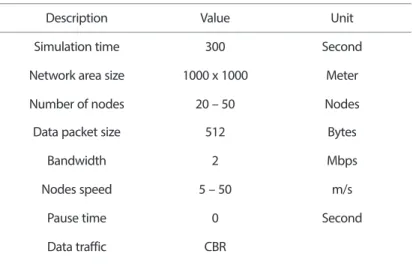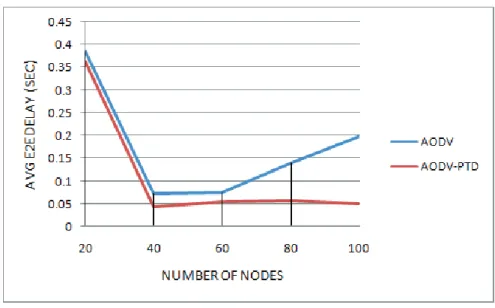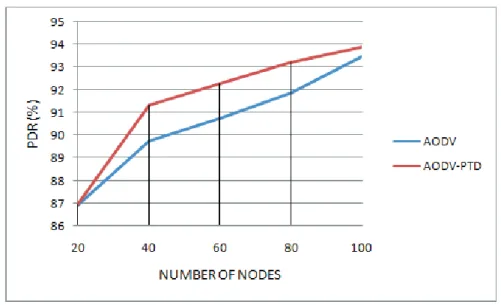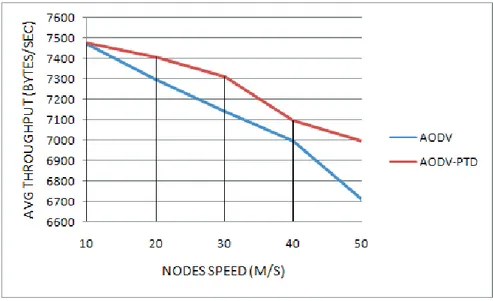61 ARAŞTIRMA MAKALESİ / RESEARCH ARTICLE
EFFICIENT ROUTING DISCOVERY ALGORITHM IN MANET Bakr Kamal Jasim ALANI1
1ALTINBAŞ University, School of Engineering and Natural Science, Mahmutbey, Istanbul, Turkey
bakir_alani92@yahoo.com ORCID: 0000-0001-9500-3412 Çağatay AYDIN1
1ALTINBAŞ University, School of Engineering and Natural Science, Mahmutbey, Istanbul, Turkey
cagatay.aydin@altinbas.edu.tr ORCID: 0000-0002-1895-0333 Dogu Cagdas ATİLLA1
1ALTINBAŞ University, School of Engineering and Natural Science, Mahmutbey, Istanbul, Turkey
cagdas.atilla@altinbas.edu.tr ORCID: 0000-0002-4249-6951
GELİŞ TARİHİ/RECEIVED DATE: 08.01.2019 KABUL TARİHİ/ACCEPTED DATE: 24.12.2019
Abstract
There is a recent wireless technology called Mobile Ad-hoc Network (MANET) with a vast range of applications. MANET without infrastructure leads to routing faces challenges. A broadcasting technique is utilized in a MANET to find a route in on-demand routing protocols. Establishment and regular maintenance of a route represent the important challenge issues. Therefore, nodes require to control the broadcast packets among themselves. This situation leads to broadcast storm problem, which increases link breakage, reduce the duration and decreases the overall performance of the network. The commonly ideal protocol of MANET is reactive routing protocols, due to less control overhead and scalability. However, due to the mobility of the nodes, there is a frequent link breakages they are continually suffers and a new reactive routing protocol is proposed Aware Ad-Hoc On-demand Distance Vector routing protocol - Power and Time Direction Predication (PTD) aim to handle the diminish the connection breakages and get a steady route in Ad-Hoc networks. AODV-PTD evidence the route discovery and route reply depending on the power, time of the taking an interest hubs and their headings. In addition, the proposed AODV-PTD algorithm reduced the network overhead. Network reenactment version 2.35 (NS2.35) was utilized for looking at the proposed calculation with AODV routing protocol in terms end-to-end delay, average throughput, and packet delivery ratio.
Keywords: wireless ad-hoc network, mobile ad-hoc network, reactive routing protocol, aware ad-hoc on-demand distance vector, AODV, MANET.
MANET İÇİN VERİMLİ YÖNLENDİRME KEŞİF ALGORİTMASI
Özet
Mobil Tasarsız Ağ (Mobile Ad-Hoc Network - MANET), günümüzde çeşitli uygulamalara sahip yeni nesil kablosuz haberleşme ağlarında birdir. Ancak altyapısız olan MANET sıklıkla yönlendirme sorunlarıyla karşılaşmaktadır. İsteğe bağlı yönlendirme protokollerinde bir yol bulmak için MANET’te özel bir yayın tekniği kullanılmaktadır.
62
Bir rotanın kurulması ve düzenli bakımı göz önünde bulundurulması gereken başlıca zorluklarındandır. Bu nedenle, düğümlerin yayın paketlerini kendi aralarında kontrol etmeleri gerekir. Bu durum, bağlantı kopmasını artıran, süreyi azaltan ve ağın genel performansını azaltan yayın fırtınası sorununa yol açar. İdeal MANET protokolü olarak genellikle ek yükün daha az kontrol edilmesinin gerekmesi ve ölçeklenebilirlik nedeniyle reaktif yönlendirme protokolleri kullanılmaktadır. Bu çalışmada düğümlerin hareketliliği nedeniyle, sıklıkla bağlantı kopması önlemek için Farkındalıklı Tasarsız Geçici Mesafe Vektörü Yönlendirme Protokolü - Güç ve Zaman Yön Tahmini (Aware Ad-Hoc On-demand Distance Vector Routing Protocol - Power and Time Direction Predication - AODV-PTD) diye adlandırılan yeni bir reaktif yönlendirme protokolü önerilmektedir. Böylece tasarsız ağlarda bağlantı kopmalarının azaltılması ve istikrarlı bir yol izlenmesi hedeflenmektedir. AODV-PTD, güce, ilgili merkezlerde geçirdiği süreye ve başlıklarına bağlı olarak rotanın bulunması ve rotanın cevabını tespit etmeyi amaçlamaktadır. Bunlara ek olarak, önerilen AODV-PTD algoritması ağ yükünü düşürmektedir. Önerilen AODV yönlendirme protokolünün, uçtan uca gecikmesini, ortalama doğrudan veri transferi ve paket teslim oranını analiz etmek için Network Reenactment v2.35 (NS2.35) programı kullanılmıştır.
Anahtar Kelimeler: kablosuz ad-hoc ağlar, mobil ad-hoc ağlar, reaktif yönlendirme protokolü, farkındalıklı ad-hoc geçici mesafe vektörü yönlendirme protokolü, AODV, MANET
1. INTRODUCTION
Mobile Ad-hoc Network (MANET) had been a popular field of study during the last few years. MANET is a self-designing nodes in network of and associated without control. In MANET is multi-hop wireless network connection, without base station and changes dynamically structure of the network, shown in Figure 1. There are two cases when the data is transmitted by a mobile node to a destination node which depend on the range of wireless transmission. The first case, if two mobile nodes within transmission ranges, which that can communicate together directly. The second, a set of intermediate nodes is determined between the source and the destination nodes by the source node. When the source node (S) needs to transmit a packet to the node (A) this can connect directly, due to the two nodes in the transmission range. Another hand, the node S need to transmit the packet to the node B, The node B is out the transmission range, therefore, they cannot connect directly, the node A act an intermediate node to forward the packet between them. In order to find an optimal set of intermediate nodes between the source and the destination node process is called as route discovery.
MANET nodes have random mobility in the network. The nodes are consisted smart phones, tablets, and laptops. MANET is one of the most important technologies in wireless communication in that has wide application field (Alani and Alsaqour, 2017).
63
Figure 1. Example MANET communication scheme
The major features of MANET are high flexibility, easy installation and quick configuration. Due to that MANET has an extensive variety of uses which can be directly applied to many real life scenarios, such that military operations such as battlefields, emergency services such as disaster recovery, network sensor, educational applications (Murthy and Manoj, 2004), (Mohapatra and Krishnamurthy, 2004), (Umamaheswaran et al, 2014), (Pullin and Pattinson, 2008).
On the other hand, there are some challenges that ought to be reduced the irritant challenges are mentioned limited bandwidth, routing overhead, limited battery, and link breakage (Habib et al, 2013), (Yang and Vaidya, 2005), (Aarti, 2013). The Changing the topology and link breakage in MANET, for determining a path from source node to the destination node we give rise to design an efficient routing protocol (Li et al, 2013).
In MANET, transmitting the packet from a source node to all nodes utilizes a simple airing procedure. Broadcasting is a major communication in MANETs. The widely recognized mythology for broadcasting is blind flooding. Flooding is well used for MANETs as it needs no topological information (Tseng et al, 2002), (Ruiz and Bouvry, 2015).
2. ROUTING PROTOCOL OF MANET
A considerable measure of routing protocols have been suggested to accomplish the objective of dependable routing with less control overhead in the MANET (Umamaheswaran et al, 2014). The protocol which is responsible for establishing and maintaining the path from the source to the destination node is the routing protocol in MANET. Although, there are different suitable options from the source to the
64
destination node, the routing protocol must determine the best option and perform communication through that way. The optimum path may be aware of distance or the number of hops (Patel et al, 2014), (Shenbagapriya and Kumar, 2014). These criteria depends on the application area (Boukerche et al, 2011). To maximize the throughput while minimizing packet loss are the important aims of the routing protocols, control overhead, and energy usage. The routing protocols in MANET are ordered into three groupings based on their usefulness and execution, which included proactive, reactive, and hybrid routing protocols (Sarkar and Paul, 2015).
3. AD-HOC ON-DEMAND DISTANCE VECTOR ROUTING PROTOCOL
Perkins et al (2003), the AODV routing protocol was investigated. The AODV routing protocol combines the advantage of DSR protocols (Perkins et al, 2003) and (DSDV). AODV has the advantages of the (DSDV) protocol as it has arrangement numbers for keeping up the most recent data between nodes, and it has the benefits of the DSR, such as creating routes on interest and building the way between the sender and beneficiary through the route revelation mechanism. Reducing the number of broadcast messages is The goal of the AODV protocol forwarded through the network by findingjroutes on-demand rather than update the route information (Boukerche et al, 2011). AODV is one of the most important reactive routing protocols, and it is widely used in MANETs. The AODV protocol has four control message are utilized for discovering and maintaining mechanisms routes to the destination. These control messages are RREQ message, a Hello message, RERR message, and RREP message (Perkins et al, 2003).
4. THE PROPOSED ALGORITHM
The topology in MANET network is change typically that driven by the frequent changes occur when node move freely with no direction. This causes link breakage between node when transfer data and packet. Due to this, the source node broadcast procedure to established links between nodes network can be expired frequently.
To reduce the link breakage in AODV routing protocol, the proposed algorithm AODV Power, Time and Direction Predication (PTD) design to implemented base on original AODV protocol and the AODV-PTI scheme proposed by Alani and Alsaqour (2017) , and the EOAODV algorithm proposed by Gouda et al (2013).
Alani and Alsaqour (2017) proposed a scheme, namely AODV–PTI to lessen the superfluous control packets for disclosure routing. And focused on the information arrival and timing about recvRequest, recvError, and recvHello packet, then check the information and determine the route.
Gouda et al (2013) presented an Energy Optimal on demand routing protocol which alters communicated component of consentient AODV routing protocol. In this procedure, if an answer is lost, new route discovery method must be reinitiated.
The AODV-LTP algorithm make to check the power, time and direction of last three arrived packets. If the last three power is lower than the previous power (p1, p2, p3), and the time is greater than the previous
65
time, then it is required to check the direction of previous node. The AODV-LTP algorithm send the REPAIR massage to up node, that able to predict the status of bad routing path.
Both of the recvRequest, recvError, and recvHello functions have information about power and timing. Although only RREQ packets are ordinarily thought about when processing the communicated likelihood, in AODV-LTP algorithm, we use the timing data and power data linked with a packet touching base at the present node.
The goal of the AODV-LTP algorithm is to avoid link breakage and reduce the number of broadcast packets that are sent accordingly, AODV-LTP algorithm will be completely versatile, dynamic calculation that can alter broadcast frequency utilizing all accessible packet timing data that touches base at the node. Consequently, the execution of the AODV routing protocol will be pushed ahead.
5. SIMULATION ENVIRONMENT
To assess the execution of the calculation, we utilized NS-2.35, (Keshav, 1988). The mobility model utilize the random waypoint model (Navidi and Camp, 2004). In this model, the mobile nodes are moving freely and randomly without border limitation. The application layer at node generates CBR traffic. The transmission range is 200 meter (m) chosen. The node’s delay time is consistent to 0 to make the nodes movement constant. The quantity of nodes in the network was selected small network 20 nodes to large network 100 nodes. The maximum nodes speed chosen as between 5 m/s human speed to 50 m/s vehicle speed, all scenarios are place in 1000 m x 1000 m square area. The summary of the simulation parameters are given in Table 1.
Table 1. The simulation parameters
Description Value Unit
Simulation time 300 Second
Network area size 1000 x 1000 Meter
Number of nodes 20 – 50 Nodes
Data packet size 512 Bytes
Bandwidth 2 Mbps
Nodes speed 5 – 50 m/s
Pause time 0 Second
66
5.1 Performance Metric
Performance metrics are used to measure the efficiency the proposed algorithm, and they utilized in the comparative study. The performance measure in this study algorithm is measured using: Average End-to-End Delay (Avg.E2E Delay), Average Throughput (Avg.TH), and Packet Delivery Ratio (PDR)
5.1.1 Average End-to-End Delay (AvgE2E Delay)
The data packet reaches the destination with the average time. To calculate this metric, the time that first packet was transmitted from the source was subtracted from the time when the first data packet arrived to destination. The delay by path discovery could be determined with this metric.
5.1.2 Average Throughput (Avg Throughput)
The Avg Throughput is the ratio of the number of data packets successfully delivered at the destination over the time between receiving the first and the last packets the simulation time.
5.1.3 Packet Delivery Ratio (PDR)
PDR is the ratio between a number of sending data packets and truly received data packets. 6. RESULTS AND DISCUSSIONS
The performance of AODV-LTP algorithm was compared with that of AODV protocol using the performance metrics mentioned above. Results showed that AODV-PTI shows better performance than AODV in terms of E2End Delay, Avg-Throughput, and PDR. This study in order to compare the performance of AODV-LTP algorithm based on different the number of nodes and speed ratio.
6.1 Comparison Result Based on The Number of Nodes
The network density is a decisive parameter. In this simulation, the number of nodes under different network density was set to 20, 40, 60, 80, and 100 nodes and each node has a maximum speed of 20 m/s for all the network parameters.
67
Figure 2. E2E delay vs. number of nodes
Figure 2 shows the difference in E2E Delay by comparing the proposed AODV-PTD algorithm with the original AODV protocol. The figure represents a significant difference in the E2E Delay among these protocols.
Figure 3. Avg-throughput vs. number of nodes
In Figure 3 revealed that there is an increase in Avg Throughput of the proposed AODV-PTD algorithm when compared original AODV.
68
Figure 4. PDR vs. number of nodes
The comparison results of PDR between the protocols is given in Figure 4. The graph shows, the PDR dramatically in the AODV-PTD algorithm increases when moving from a high-density area to a low-density area.
6.2 Comparison Result Based on Node Speed
in this section, discuss the effect of network speed on the algorithm. the comparison result of the route discovery in terms of avg throughput, avg e2e delay, and pdr, based on the node speed 10 m/s, 20 m/s, 30 m/s, 40 m/s, 50 m/s respectively was calculated.
69
Figure 5 shows the Avg E2E Delay of the data package for the route discovery protocol based on the different speed nodes. The results of the proposed AODV-PTD algorithm yield on significantly less delay as compared to the original AODV.
Figure 6. Avg-throughput vs. speed of nodes
The Avg Throughput result based on the ratio of the speeds of data transfer within nodes is shown in Figure 6. The result advised that proposed AODV-PTD algorithm has significantly outperformed on original AODV. This is evident from the result, especially when the speed ratio of the nodes increases gradually.
Figure 7. PDR vs. speed of nodes
Figure 7 illustrates the comparison result of the PDR of packet based on the speed of nodes. The highest PDR was spotted when using the proposed AODV-PTD algorithm at different speed varies.
70
7. CONCLUSION
In this paper, the proposed AODV-PTD algorithm lead to decrease unnecessary control packets in route discovery and maintenance of routes between the source node and the destination node when link breakage occurs. After analyzing the result, it can be evidenced that the proposed AODV-PTD outperformed the original AODV. The network performance result of AODV-PTD against the AODV in terms of the number of nodes and speed ration between nodes yield on a higher throughput, PDR, and less E2E delay. This can be referred to the feasibility of the proposed algorithm in getting the power, time and direction of the last three packets. Such process helped to reduce the link breakage in the route network when transferring data in different destinations.
REFERENCES
Alani, H., and Alsaqour, R. 2017. Routing discovery scheme for high mobility in MANET. ARPN Journal of Engineering and Applied Sciences, 12(2), 536-543.
Murthy, C. S. R., and Manoj, B. S. 2004. Ad hoc wireless networks: Architectures and protocols, portable documents. Pearson education.
Mohapatra, P., and Krishnamurthy, S. (Eds.). 2004. AD HOC NETWORKS: technologies and protocols. Springer Science & Business Media.
Umamaheswaran, S., Kumar, N., and Biswas, P. K. 2014. A survey of routing protocol design patterns for mobile ad hoc networks., In 2014 2nd International Conference on Emerging Technology Trends in Electronics, Communication and Networking (pp. 1-6). IEEE.
Pullin, A. J., and Pattinson, C. 2008. A realistic battlefield model for the evaluation of MANET., In 2008 Fifth Annual Conference on Wireless on Demand Network Systems and Services (pp. 81-84). IEEE. Habib, S., Saleem, S., and Saqib, K. M. 2013. Review on MANET routing protocols and challenges., In 2013 IEEE Student Conference on Research and Developement (pp. 529-533). IEEE.
Yang, X., and Vaidya, N. 2005. On physical carrier sensing in wireless ad hoc networks., In Proceedings IEEE 24th Annual Joint Conference of the IEEE Computer and Communications Societies (Vol. 4, pp. 2525-2535). IEEE.
Aarti, D. S.S. 2013. Tyagi, Study Of Manet: Characteristics, challenges, application and security attacks., International Journal of Advanced Research in Computer Science and Software Engineering, 3(5), 252-257. Li, S., Lou, L., and Hong, L. 2013. Directional probabilistic broadcast in wireless mobile ad hoc networks., In 2013 International Conference on Computational and Information Sciences (pp. 1421-1424). IEEE. Tseng, Y. C., Ni, S. Y., Chen, Y. S., and Sheu, J. P. 2002. The broadcast storm problem in a mobile ad hoc network, Wireless networks, 8(2-3), 153-167.
71 Ruiz, P., and Bouvry, P. 2015. Survey on broadcast algorithms for mobile ad hoc networks., ACM computing
surveys (CSUR), 48(1), 1-35.
Patel, D. N., Patel, S. B., Kothadiya, H. R., Jethwa, P. D., and Jhaveri, R. H. 2014. A survey of reactive routing protocols in MANET., In International Conference on Information Communication and Embedded Systems (ICICES2014) (pp. 1-6). IEEE.
Shenbagapriya, R., and Kumar, N. 2014. A survey on proactive routing protocols in MANETs., In 2014 International Conference on Science Engineering and Management Research (ICSEMR) (pp. 1-7). IEEE. Boukerche, A., Turgut, B., Aydin, N., Ahmad, M. Z., Bölöni, L., and Turgut, D. 2011. Routing protocols in ad hoc networks: A survey., Computer networks, 55(13), 3032-3080.
Sarkar, P., and Paul, H. 2015. Performance Comparison of AODV, DSR, DYMO and TORA Routing Protocols in Mobile Ad Hoc Networks., Int. J. on Network Security, 6.
Perkins, C., Belding-Royer, E., and Das, S. 2003. RFC3561: Ad hoc on-demand distance vector (AODV) routing.
Gouda, B. S., Panigrahi, P. P., and Choudhury, A. 2013. A new optimal approach for improving energy efficiency in wireless ad-hoc networks., In 2013 IEEE Conference on Information & Communication Technologies (pp. 1095-1100). IEEE.
Keshav, S. 1988. REAL: A network simulator., University of California Berkeley, Calif, USA.
Navidi, W., and Camp, T. 2004. Stationary distributions for the random waypoint mobility model., IEEE transactions on Mobile Computing, 3(1), 99-108.



